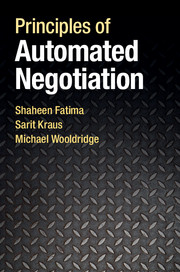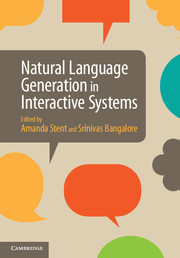Refine search
Actions for selected content:
3326 results in Artificial Intelligence and Natural Language Processing
References
-
- Book:
- Principles of Automated Negotiation
- Published online:
- 05 November 2014
- Print publication:
- 13 November 2014, pp 246-266
-
- Chapter
- Export citation

Principles of Automated Negotiation
-
- Published online:
- 05 November 2014
- Print publication:
- 13 November 2014
SCESS: a WFSA-based automated simplified chinese essay scoring system with incremental latent semantic analysis
-
- Journal:
- Natural Language Engineering / Volume 22 / Issue 2 / March 2016
- Published online by Cambridge University Press:
- 30 October 2014, pp. 291-319
-
- Article
- Export citation
(Un/Semi-)supervised SMS text message SPAM detection
-
- Journal:
- Natural Language Engineering / Volume 21 / Issue 4 / August 2015
- Published online by Cambridge University Press:
- 15 October 2014, pp. 553-567
-
- Article
- Export citation
UIMA Ruta: Rapid development of rule-based information extraction applications
-
- Journal:
- Natural Language Engineering / Volume 22 / Issue 1 / January 2016
- Published online by Cambridge University Press:
- 08 October 2014, pp. 1-40
-
- Article
-
- You have access
- HTML
- Export citation
Exploiting extra-textual and linguistic information in keyphrase extraction
-
- Journal:
- Natural Language Engineering / Volume 22 / Issue 1 / January 2016
- Published online by Cambridge University Press:
- 30 September 2014, pp. 73-95
-
- Article
- Export citation
NLE volume 20 issue 4 Cover and Front matter
-
- Journal:
- Natural Language Engineering / Volume 20 / Issue 4 / October 2014
- Published online by Cambridge University Press:
- 15 August 2014, pp. f1-f2
-
- Article
-
- You have access
- Export citation
NLE volume 20 issue 4 Cover and Back matter
-
- Journal:
- Natural Language Engineering / Volume 20 / Issue 4 / October 2014
- Published online by Cambridge University Press:
- 15 August 2014, pp. b1-b6
-
- Article
-
- You have access
- Export citation

Knowledge Representation, Reasoning, and the Design of Intelligent Agents
- The Answer-Set Programming Approach
-
- Published online:
- 05 July 2014
- Print publication:
- 10 March 2014

Natural Language Generation in Interactive Systems
-
- Published online:
- 05 July 2014
- Print publication:
- 12 June 2014

Burden of Proof, Presumption and Argumentation
-
- Published online:
- 05 July 2014
- Print publication:
- 30 June 2014
Acknowledgments
-
- Book:
- Burden of Proof, Presumption and Argumentation
- Published online:
- 05 July 2014
- Print publication:
- 30 June 2014, pp xi-xii
-
- Chapter
- Export citation
4 - Shifting the Burden of Proof in Witness Testimony
-
- Book:
- Burden of Proof, Presumption and Argumentation
- Published online:
- 05 July 2014
- Print publication:
- 30 June 2014, pp 122-144
-
- Chapter
- Export citation
2 - Burdens of Proof in Legal Reasoning
-
- Book:
- Burden of Proof, Presumption and Argumentation
- Published online:
- 05 July 2014
- Print publication:
- 30 June 2014, pp 49-84
-
- Chapter
- Export citation
5 - Burden of Proof in Dialogue Systems
-
- Book:
- Burden of Proof, Presumption and Argumentation
- Published online:
- 05 July 2014
- Print publication:
- 30 June 2014, pp 145-175
-
- Chapter
- Export citation
3 - Presumption in Legal Reasoning
-
- Book:
- Burden of Proof, Presumption and Argumentation
- Published online:
- 05 July 2014
- Print publication:
- 30 June 2014, pp 85-121
-
- Chapter
- Export citation
6 - Solving the Problems of Burden of Proof
-
- Book:
- Burden of Proof, Presumption and Argumentation
- Published online:
- 05 July 2014
- Print publication:
- 30 June 2014, pp 176-210
-
- Chapter
- Export citation
Bibliography
-
- Book:
- Burden of Proof, Presumption and Argumentation
- Published online:
- 05 July 2014
- Print publication:
- 30 June 2014, pp 285-296
-
- Chapter
- Export citation
Frontmatter
-
- Book:
- Burden of Proof, Presumption and Argumentation
- Published online:
- 05 July 2014
- Print publication:
- 30 June 2014, pp i-iv
-
- Chapter
- Export citation
Contents
-
- Book:
- Burden of Proof, Presumption and Argumentation
- Published online:
- 05 July 2014
- Print publication:
- 30 June 2014, pp vii-x
-
- Chapter
- Export citation
